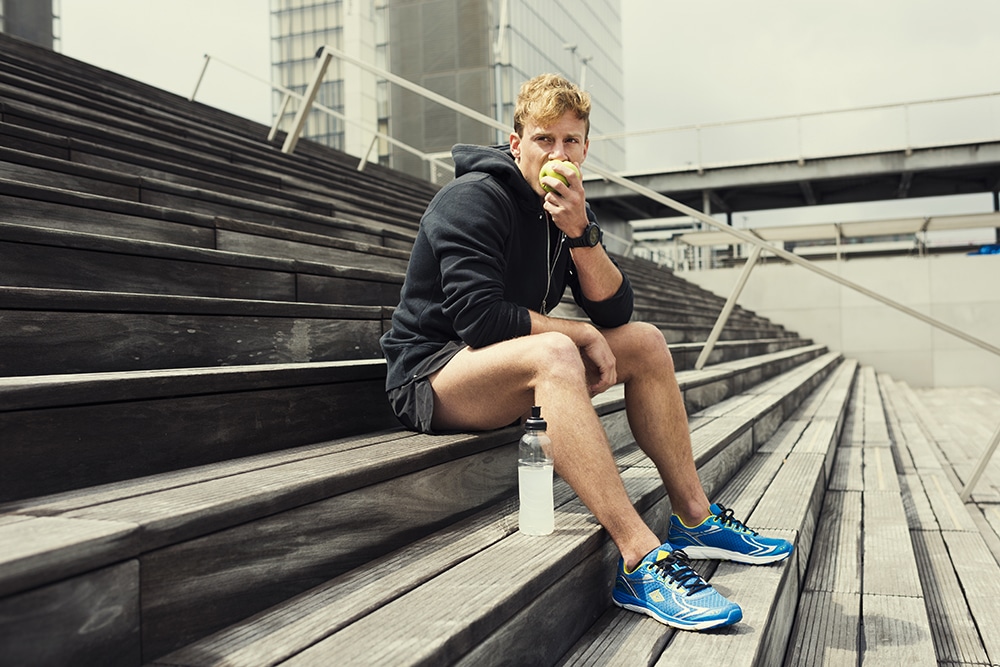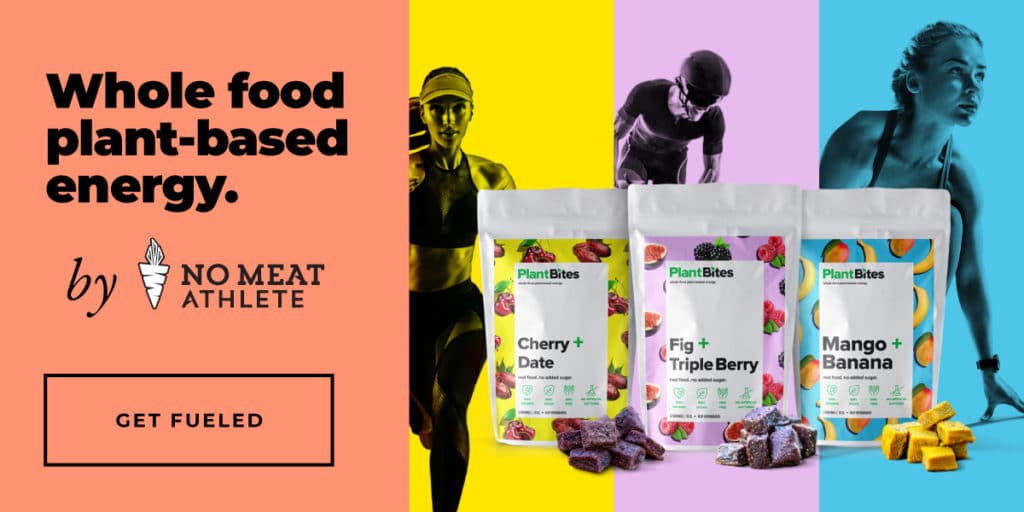
4 Common Nutrition Mistakes Vegan Athletes Can Easily Avoid
Picture this: You’re 9 miles into a dream half marathon — having the time of your life — when all of a sudden…
Bonk.
Your energy plummets and pace drops, and in a matter of minutes, all hopes for a PR go out the window.
It’s an all too familiar story just about every endurance athlete can tell.
Because for whatever reason, most of us are in a constant, WWE cage-match-style battle with workout nutrition.
But as I’ve worked on my own training and watched other athletes and friends, I’ve noticed that most plant-based endurance nutrition problems boil down to a few key mistakes…
Mistakes that if avoided, will benefit your body and mind, and take your training to an entirely new level.
Today I dive into the four most common issues and the simple steps you should take to correct them.
Mistake 1: Trying to lose weight while building a base.
The mistake:
Jess wants to lose weight and knows burning calories can help her get there, so she decides to train for a marathon to check off two boxes at once. To get an extra boost, Jess combines eating less with training more — hoping to reach her weight loss goal more quickly. Unfortunately, her runs get harder and harder, and it becomes more difficult to recover. Her fitness suffers and her weight loss goals get harder to reach as well.
The background information:
Many people start a training program with a weight-loss goal in mind.
But as a rule, you should not try to lose weight for the first several months of training for an endurance event if you want optimal performance later.
Base training is meant to prepare your body and mind for a long haul of hard training days. You are adapting your body to stress, and energy needs increase in order for your body to handle the stress of exercise. If you are in a calorie deficit during base training, it reduces your body’s ability to adapt to stress and recover — which is a crucial part of training.
Added stress without adequate recovery builds the body into an injury-prone mess, often leading to stress fractures or other serious injuries.
The solution: Prioritize nutrition.
Disconnect training from any weight loss goals and prioritize your nutrition for your training.
That means eating around your workouts, fueling during long efforts, and making sure you stay on top of your calories.
Mistake 2: Taking in fuel too late.
The mistake:
Aaron headed out on a big ride that would take a few hours to complete. Big climbs, long descents, and endless spinning burned through his calories and glycogen stores. Two-thirds of the way through his ride, he felt his energy crash and he stopped on the side of the road to take in some fuel. The rest of the ride seemed to take forever, and when he finally got home, he crashed on the couch for the rest of the day.
The background information:
The bad news: If you’ve already bonked, it’s too late! Even “quick fuel” takes time to go from food to energy.
Once you have bonked, your strength output decreases dramatically and your ability to handle stress also falls off while your heart rate usually skyrockets with very minimal strength output. Not only does this make your workout a pretty big bummer, it also impacts recovery and reduces the overall effectiveness of your training.
Not fueling properly during your workout can also leave you feeling ravenous when you’re finished since your body’s glycogen stores are depleted.
The good news: This is avoidable!
The solution: Create a workout fuel plan and routine.
Fueling during a workout should be planned and purposeful — and will take some experimenting to get it right.
Start with taking a small amount of calories (50-100 calories) every 30 minutes. For some people, it will be more often during a workout, and for others, it will be less often. Play with it and make sure you have a fueling protocol for workouts over 90 minutes! If you have a difficult time taking in workout fuel — try plant-based sources, fruits, and nuts (or Plant Bites, which were designed for this purpose).
Another strategy is to eat something sustainable before your workout so you can use that energy throughout (check out this post on what macronutrients are best for your workout type!)

Mistake 3: Failing to hydrate.
The mistake:
It’s been a long day at work, but Kathy is looking forward to her 6-mile run. She gets home, changes into running clothes, and heads out the door without sparing a thought for how much water she’s had throughout the day (not much). At first, she feels just a little thirsty but powers through. Before long, she finds herself tripping over small cracks and her pace slowing considerably, though her heart rate remains elevated.
The background information:
Depending on your workout, it’s not always easy or convenient to carry hydration, which makes it easy to skip. (I used to not bother with water for runs under 15 miles — crazy!)
Since 60% of our bodies are made of water, it stands to reason that hydrating properly is one of the most important things you can do. Skipping out on this detail can lead to dehydration, which can be quite dangerous.
Even before you reach the danger zone, you might experience a rise in body temperature and heart rate. You’ll feel fatigue set in, and you may have a hard time thinking clearly (leading to impaired motor control), and of course, your performance will suffer.
All of this falls under the category of “not good, but avoidable.”
The solution: Hydrate!
Don’t just focus on hydration during your workout, but also before and after. And not just plain water! Sipping on a plant-based electrolyte source or coconut water throughout the day will set you up for hydration success.
Mistake 4: Not refueling after a workout.
The mistake:
Ed just finished a tough track workout with visions of a half marathon PR this fall. After he got home, he showered, put on clean clothes, and crashed on the couch for another type of marathon — a Star Trek one. The next day when he went out to run an easy 4-miler, his body was not in the mood. His long run a few days later wasn’t too great either.
The background information:
Although the “recovery window” that we have all been told exists after every single workout is likely a myth, you still shouldn’t be waiting hours after a workout to fuel up. During a base training protocol, this isn’t as important, but once you get into longer and more strenuous workouts, post-workout nutrition becomes a key ingredient for success.
Not eating after a workout contributes to inflammation and stress, reducing your body’s ability to adapt to stress and recover by the time your next session arrives.
It’s important to note that as more athletes experiment with intermittent fasting, training nutrition often takes a back seat if it takes place during a fasting window. Although there may be health benefits to fasting, it is important to be extra careful during training.
The solution: Eat something after a workout.
It’s as simple as that.
It doesn’t have to be a giant meal — it can be a snack or a smoothie — but replenish those calories and you’ll be set up better for your next workout.
After a workout, your metabolism is heightened — making it a great time to replenish the muscle glycogen stores and give your body something to feast on. This is the best part of the day to eat your fruit in large quantities and smoothies (sometimes I drink an entire blender of smoothie after a tough workout because it’s not only a great source of fuel but also SUPER hydrating).
Some of us don’t have a huge appetite right after a big workout, which is fine. Just make sure you get something within 60-90 minutes of finishing a tough session.
Sometimes the Simple Solution is the Best Solution
Four common nutrition mistakes — four easy solutions!
As long as you respect and listen to your body and give it the support it needs to continue working and building, your body will support you right back with bigger PRs, exciting and inspiring adventures, and longevity.
About the Author: Izzy Fischer is an Ironman 70.3 World Championship qualifier and Nutrition M.S., and founder of our endurance fuel, Plant Bites.




Leave a Reply